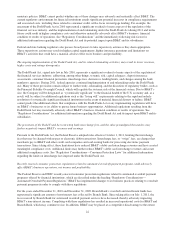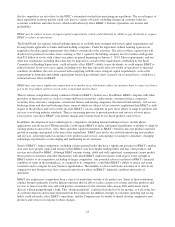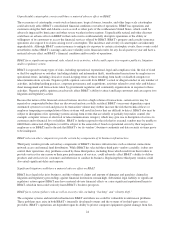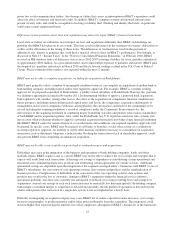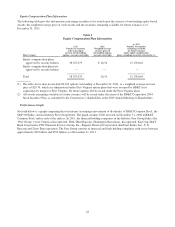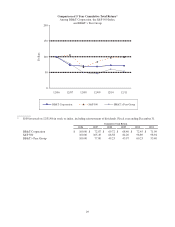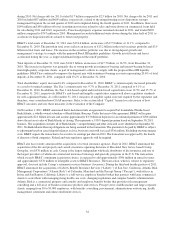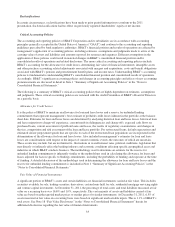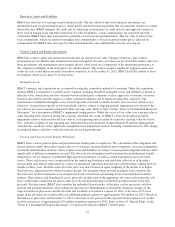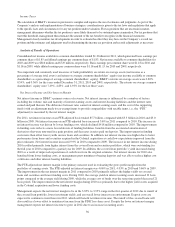BB&T 2011 Annual Report Download - page 32
Download and view the complete annual report
Please find page 32 of the 2011 BB&T annual report below. You can navigate through the pages in the report by either clicking on the pages listed below, or by using the keyword search tool below to find specific information within the annual report.during 2010. Net charge-offs for 2011 totaled $1.7 billion compared to $2.5 billion for 2010. Net charge-offs for 2011 and
2010 included $87 million and $605 million, respectively, related to the nonperforming assets disposition strategy
management began in the second quarter of 2010 and completed during the fourth quarter of 2011. In addition, there were
$149 million and $90 million of losses in noninterest income related to sales and write-downs on commercial loans held
for sale during 2011 and 2010, respectively. Foreclosed property expenses remained elevated in 2011, and totaled $802
million compared to $747 million in 2010. Management recorded additional write-downs during the latter-half of 2011 to
accelerate its disposition efforts related to foreclosed property.
BB&T’s total assets at December 31, 2011 were $174.6 billion, an increase of $17.5 billion, or 11.1%, compared to
December 31, 2010. The growth in total assets reflects an increase of $13.2 billion in the total securities portfolio and $3.9
billion in total loans and leases. The increase in the securities portfolio was due to strong deposit growth and
management’s strategy to comply with the proposed Basel III liquidity guidelines. Growth in total loans and leases
accelerated during the year, as improved demand outpaced the runoff portfolios.
Total deposits at December 31, 2011 were $124.9 billion, an increase of $17.7 billion, or 16.5%, from December 31,
2010. The increase in deposits was primarily due to strong growth in noninterest-bearing and interest-bearing balances
from high-quality corporate clients, as part of management’s efforts to comply with the proposed Basel III liquidity
guidelines. BB&T has continued to improve the deposit mix with noninterest-bearing accounts representing 20.6% of total
deposits at December 31, 2011, compared with 19.2% at December 31, 2010.
Total shareholders’ equity increased 6.0% compared to December 31, 2010. BB&T’s common equity increased primarily
as a result of retained earnings. The Tier 1 common ratio was 9.7% at December 31, 2011 compared to 9.1% at
December 31, 2010. In addition, the Tier 1 risk-based capital and total risk-based capital ratios were 12.5% and 15.7% at
December 31, 2011, respectively. BB&T’s risk-based and tangible capital ratios remain well above regulatory standards
for well-capitalized banks. As of December 31, 2011, measures of tangible capital were not required by the regulators and,
therefore, were considered non-GAAP measures. Refer to the section titled “Capital” herein for a discussion of how
BB&T calculates and uses these measures in the evaluation of the Company.
On November 1, 2011, BB&T announced that it had entered into an agreement to acquire Fort Lauderdale, Florida-based
BankAtlantic, a wholly-owned subsidiary of BankAtlantic Bancorp. Under the terms of the agreement, BB&T will acquire
approximately $2.1 billion in loans and assume approximately $3.3 billion in deposits for an estimated premium of $301 million
above the net asset value of BankAtlantic at closing. This represents a 9.05% deposit premium based on September 30, 2011
balances. The acquisition excludes all of BankAtlantic’s nonperforming and other criticized assets identified at September 30,
2011. No BankAtlantic Bancorp obligations are being assumed in the transaction. The premium to be paid by BB&T is subject
to adjustment based on actual deposit balances at close, but in no event will it exceed $316 million. Excluding one-time merger
costs, BB&T expects the transaction to be accretive to earnings per share in 2012. The transaction was approved by the boards
of directors of both companies. Federal and state regulatory approvals will be required.
BB&T also has recently announced the acquisitions of several insurance agencies. Early in 2012, BB&T announced the
acquisition of the life and property and casualty insurance operating divisions of Roseland, New Jersey-based Crump
Group Inc. for $570 million in cash. Crump is the largest independent wholesale distributor of life insurance and one of
the largest providers of wholesale commercial insurance brokerage and specialty programs in the U.S. The transaction,
which exceeds BB&T’s minimum acquisition criteria, is expected to add approximately $300 million in annual revenue
and approximately $570 million of intangible assets to BB&T Insurance. The transaction, which is subject to regulatory
approval, does not include Crump’s retirement services business (Ascensus). During the third and fourth quarters of 2011,
BB&T announced the acquisitions of Liberty Benefit Insurance Services (“Liberty”) of San Jose, California, Atlantic Risk
Management Corporation (“Atlantic Risk”) of Columbia, Maryland and the Precept Group (“Precept”), with offices in
Irvine and San Ramon, California. Liberty is a full-service employee benefits broker that partners with large commercial
clients to assist them with managing rising health care costs, changing regulations and complex benefits administration.
Atlantic Risk is a commercial property and casualty and employee benefits broker that provides risk management
consulting and a full array of business insurance products and services. Precept serves middle-market and large corporate
clients, ranging from 50 to 50,000 employees, with benefits consulting, procurement, administration outsourcing, health
management, retirement and online enrollment services.
32


